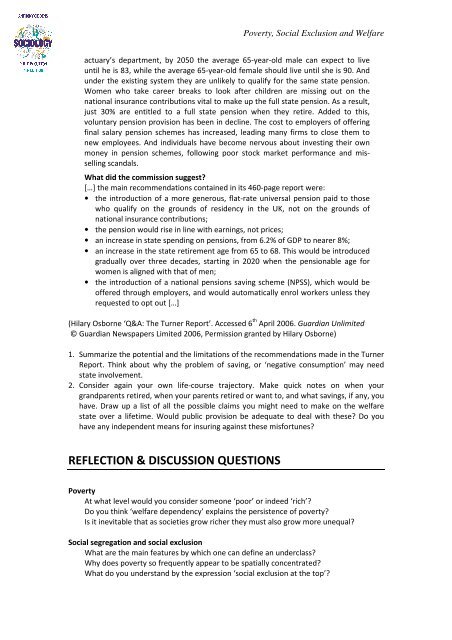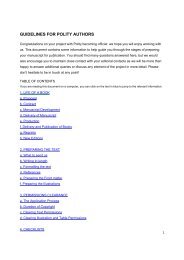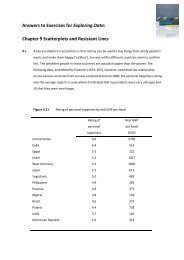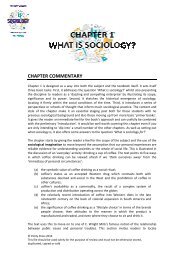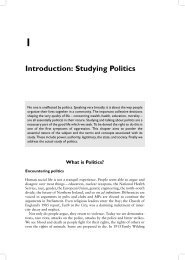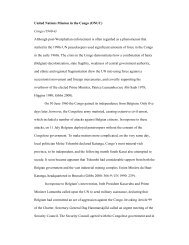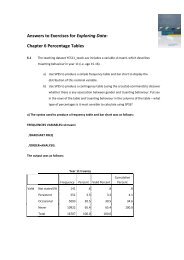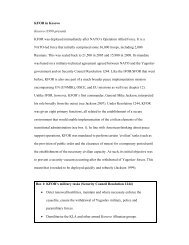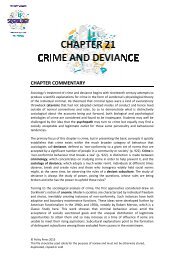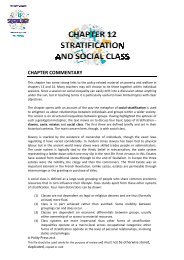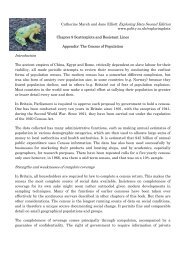Chapter 13 - Poverty, Social Exclusion and Welfare - Polity
Chapter 13 - Poverty, Social Exclusion and Welfare - Polity
Chapter 13 - Poverty, Social Exclusion and Welfare - Polity
You also want an ePaper? Increase the reach of your titles
YUMPU automatically turns print PDFs into web optimized ePapers that Google loves.
<strong>Poverty</strong>, <strong>Social</strong> <strong>Exclusion</strong> <strong>and</strong> <strong>Welfare</strong><br />
actuary’s department, by 2050 the average 65-year-old male can expect to live<br />
until he is 83, while the average 65-year-old female should live until she is 90. And<br />
under the existing system they are unlikely to qualify for the same state pension.<br />
Women who take career breaks to look after children are missing out on the<br />
national insurance contributions vital to make up the full state pension. As a result,<br />
just 30% are entitled to a full state pension when they retire. Added to this,<br />
voluntary pension provision has been in decline. The cost to employers of offering<br />
final salary pension schemes has increased, leading many firms to close them to<br />
new employees. And individuals have become nervous about investing their own<br />
money in pension schemes, following poor stock market performance <strong>and</strong> misselling<br />
sc<strong>and</strong>als.<br />
What did the commission suggest?<br />
[…] the main recommendations contained in its 460-page report were:<br />
• the introduction of a more generous, flat-rate universal pension paid to those<br />
who qualify on the grounds of residency in the UK, not on the grounds of<br />
national insurance contributions;<br />
• the pension would rise in line with earnings, not prices;<br />
• an increase in state spending on pensions, from 6.2% of GDP to nearer 8%;<br />
• an increase in the state retirement age from 65 to 68. This would be introduced<br />
gradually over three decades, starting in 2020 when the pensionable age for<br />
women is aligned with that of men;<br />
• the introduction of a national pensions saving scheme (NPSS), which would be<br />
offered through employers, <strong>and</strong> would automatically enrol workers unless they<br />
requested to opt out […]<br />
(Hilary Osborne ‘Q&A: The Turner Report’. Accessed 6 th April 2006. Guardian Unlimited<br />
© Guardian Newspapers Limited 2006, Permission granted by Hilary Osborne)<br />
1. Summarize the potential <strong>and</strong> the limitations of the recommendations made in the Turner<br />
Report. Think about why the problem of saving, or ‘negative consumption’ may need<br />
state involvement.<br />
2. Consider again your own life-course trajectory. Make quick notes on when your<br />
gr<strong>and</strong>parents retired, when your parents retired or want to, <strong>and</strong> what savings, if any, you<br />
have. Draw up a list of all the possible claims you might need to make on the welfare<br />
state over a lifetime. Would public provision be adequate to deal with these? Do you<br />
have any independent means for insuring against these misfortunes?<br />
REFLECTION & DISCUSSION QUESTIONS<br />
<strong>Poverty</strong><br />
At what level would you consider someone ‘poor’ or indeed ‘rich’?<br />
Do you think ‘welfare dependency’ explains the persistence of poverty?<br />
Is it inevitable that as societies grow richer they must also grow more unequal?<br />
<strong>Social</strong> segregation <strong>and</strong> social exclusion<br />
What are the main features by which one can define an underclass?<br />
Why does poverty so frequently appear to be spatially concentrated?<br />
What do you underst<strong>and</strong> by the expression ‘social exclusion at the top’?


